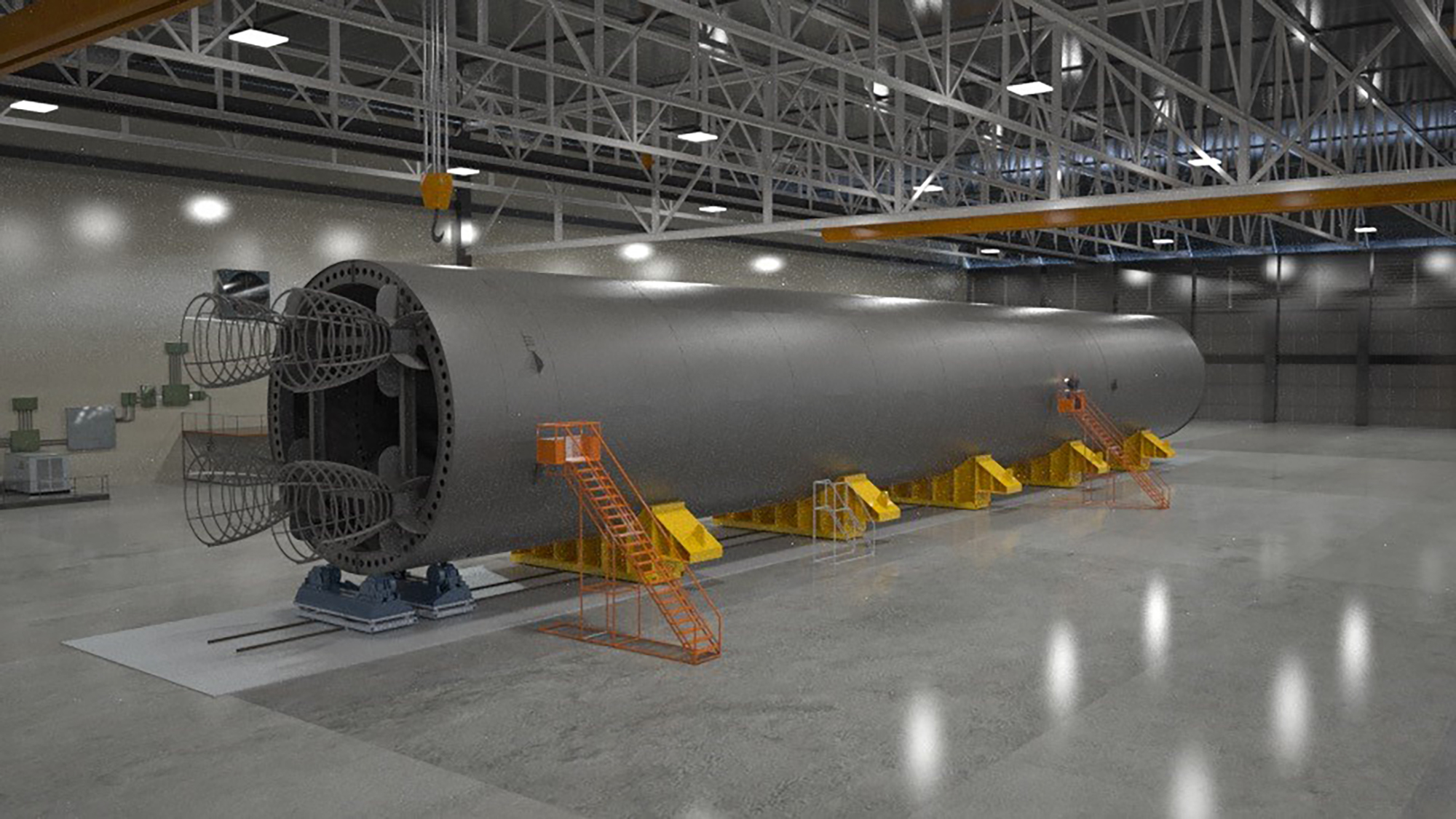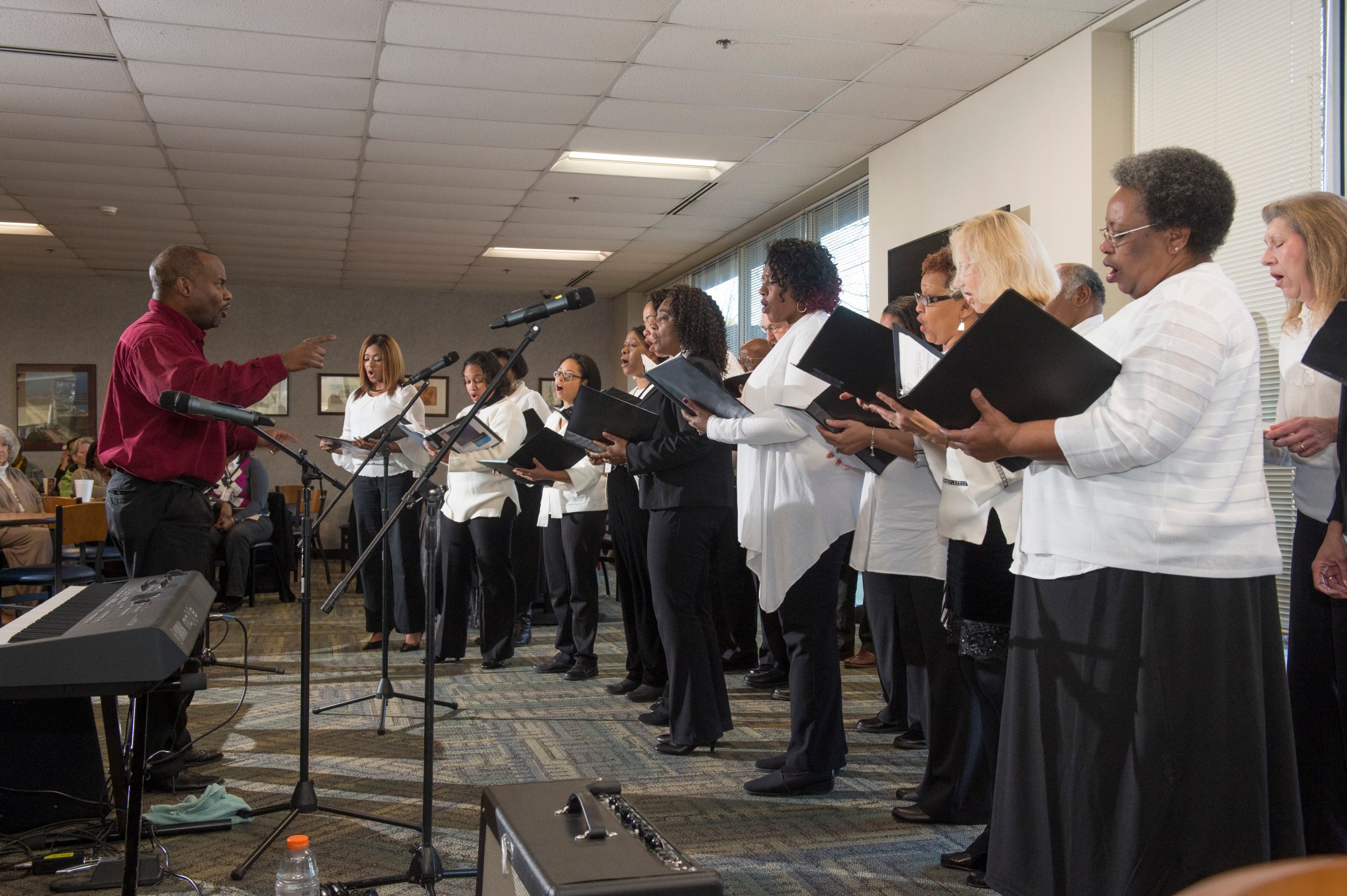In This Week’s Star
- The Making of a Mockup: Work Begins on NASA SLS Core Stage Pathfinder
- U.S. Sen. Bill Nelson Views Space Launch System Progress at Marshall
- Real Space Food is the Name of the Game for These Alabama Students
- Marshall Treads ‘Hallowed Grounds’ for Black History Month 2016
- This Week in NASA History: First Saturn Operational Payload, Pegasus-1 Launches — Feb. 16, 1965
- Obituaries
The Making of a Mockup: Work Begins on NASA SLS Core Stage Pathfinder
By Megan Davidson
Major work is beginning in three Alabama communities on a 213-foot, 230,000-pound simulation of the core stage of NASA’s new rocket, the Space Launch System.
SLS will be the world’s most powerful rocket for deep-space missions. The core stage, with flight hardware currently in production at NASA’s Michoud Assembly Facility, will stand more than 200 feet tall and store cryogenic liquid hydrogen and liquid oxygen that will feed the vehicle’s RS-25 engines.
The steel mockup, designed by engineers at NASA’s Marshall Space Flight Center, will demonstrate core stage operations and transportation, including routes for testing, assembly and launch. “This hardware is an excellent proving ground for the core stage — from manufacturing and assembly to the launch site,” said Shane Carpenter, engineering lead on the core stage pathfinder project at Marshall. “We don’t want the first time we transport the core stage to be with flight hardware. That’s why having a pathfinder is critical to the program.”
Radiance Technologies of Huntsville recently was selected by NASA to build, assemble and transport the pathfinder vehicle. The low-cost, core stage reproduction will be built at Dynetics’ facility in Huntsville and G&G Steel in Russellville, Alabama. It will be a “shell” of the core stage, with no engines or avionics.
“We look forward to working with these companies on such an important project for SLS,” said David Adcock, Stages pathfinder project lead at Marshall. “We want to ensure that the form and fit of the entire process for the core stage is successful, and any issues are addressed, before the flight hardware leaves Michoud. It helps reduce risk and keeps us on schedule.”
After manufacturing, the high-precision pieces will be trucked to the G&G Steel plant in the small town of Cordova, Alabama, for final welding and assembly. The company stands close to the Black Warrior River, where the pathfinder will travel by barge to Michoud. Transport will be done by Barnhart Crane and Rigging of Huntsville.
The pathfinder is scheduled to be completed and delivered to NASA in early 2017.
Once the pathfinder is successfully delivered to Michoud, NASA will place it on the Pegasus barge to further validate all modifications made to the vessel for core stage transportation. Refurbishments have been made to the barge to accommodate the sheer size of the massive core stage include a new, 165-foot center section, which brings the total length of the barge from 260 feet to 310 feet.
The mockup then will be shipped to NASA’s Stennis Space Center and fit vertically in the B-2 test stand. The test stand is being completely refurbished for core stage testing in 2017. The pathfinder will travel again to NASA’s Kennedy Space Center in Florida and placed vertically in the Vehicle Assembly Building, which also is undergoing major renovations for SLS. At both locations, the pathfinder will be used to ensure all modifications meet SLS core stage specifications.
Watch an animation of the pathfinder being fit in the B-2 stand at Stennis here.
Davidson, an ASRC Federal/Analytical Services employee, supports the Office of Strategic Analysis & Communications.
U.S. Sen. Bill Nelson Views Space Launch System Progress at Marshall
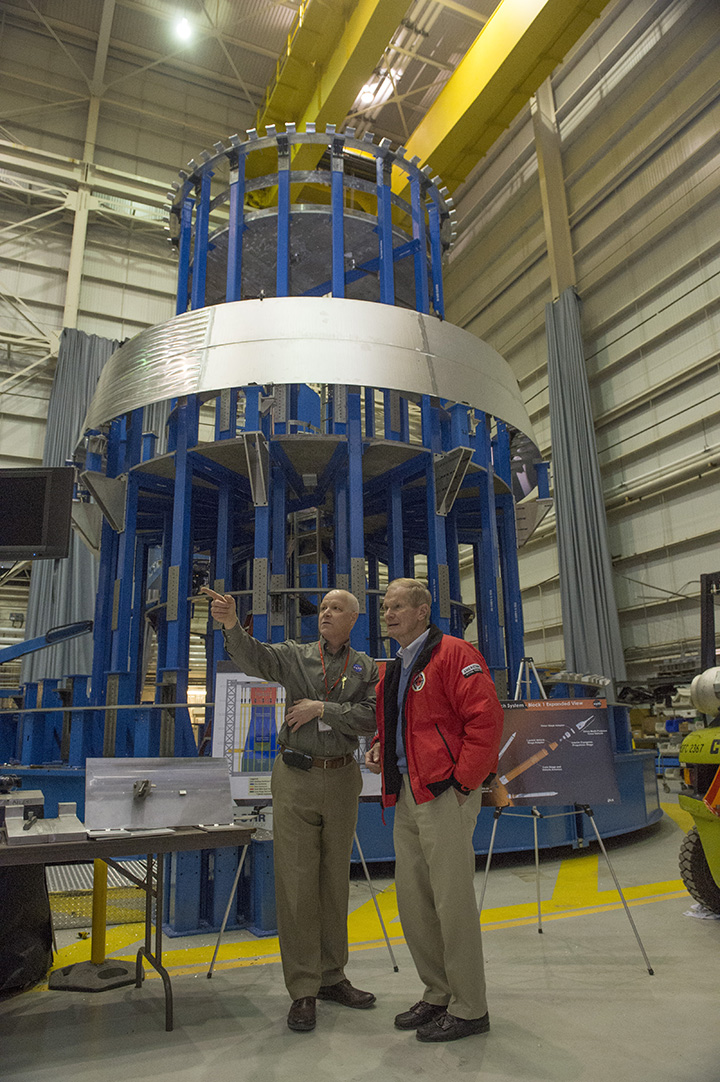
U.S. Sen. Bill Nelson of Florida, right, listens as Andy Schorr, assistant manager for Spacecraft/Payload Integration and Evolution, explains the progress of NASA’s Space Launch System — the largest rocket ever built, that will carry humans and equipment to deep-space destinations — during a visit to NASA’s Marshall Space Flight Center on Feb. 12. The senator was given a detailed description of how the Marshall team tests avionics systems, flight software and hardware, including the Launch Vehicle Stage Adapter for the SLS rocket. The LVSA will connect two major sections of the SLS — the core stage and the interim cryogenic propulsion stage. No stranger to human spaceflight, Nelson flew as a payload specialist aboard space shuttle Columbia, during the STS-61C mission in 1986. (NASA/MSFC/Emmett Given)
Real Space Food is the Name of the Game for These Alabama Students
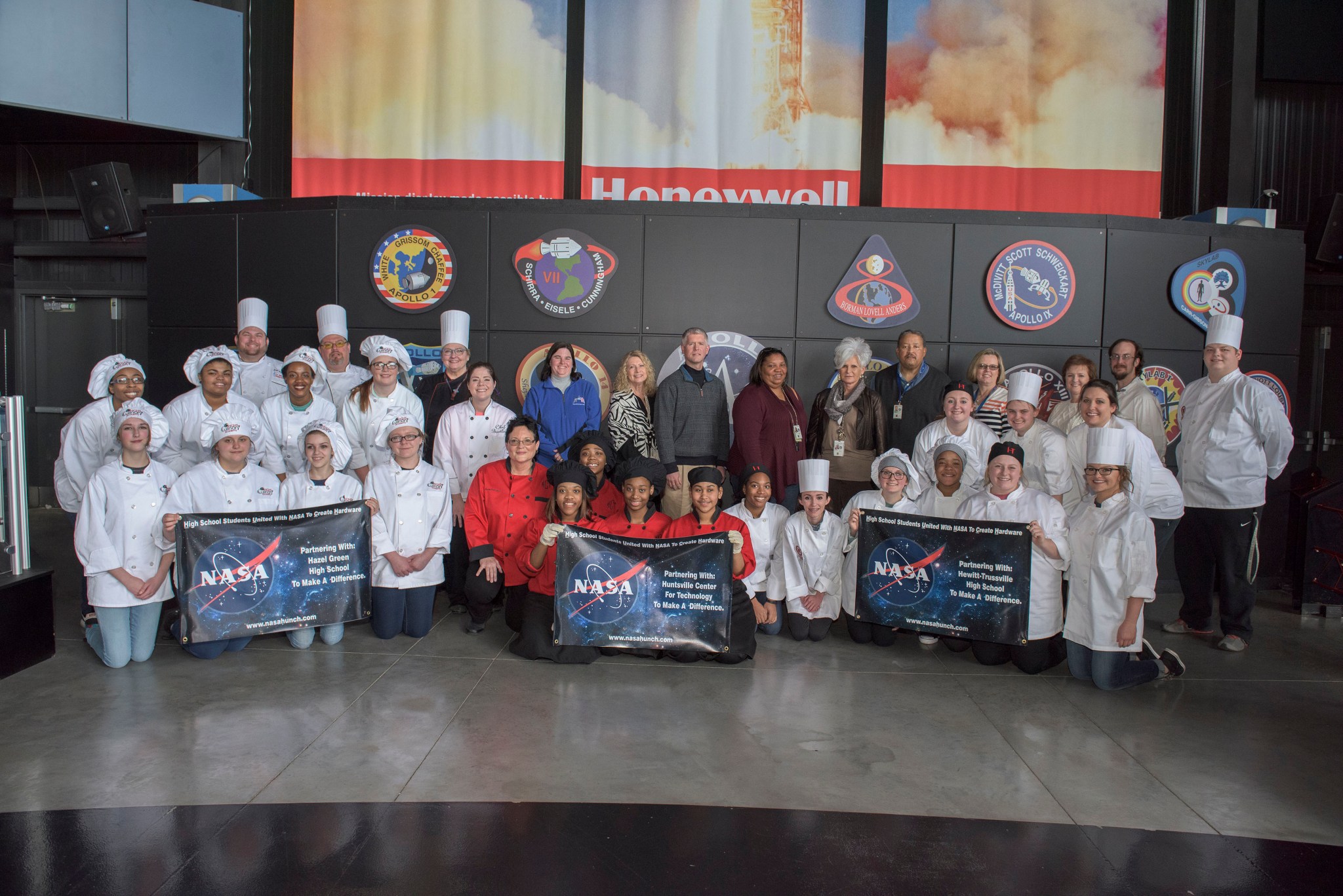
On Feb. 10, students from three Alabama schools competed in a nationwide NASA challenge, held at the U.S. Space & Rocket Center in Huntsville, to have their recipes served to astronauts aboard the International Space Station. The Culinary Cook-off Challenge is part of NASA’s HUNCH program, or High Schools United with NASA to Create Hardware. Students from Hazel Green High School, Huntsville Center for Technology and Hewitt-Trussville High School in Birmingham, presented their meals to a panel of chef and engineer judges. Selected teams will present their final entrées to a panel of astronauts at NASA’s Johnson Space Center in April. The winning entrée will be processed for flight and become part of the space station food network. NASA’s Marshall Space Flight Center currently has 18 Space Act agreements with HUNCH-affiliated high schools throughout Alabama, Mississippi, Tennessee, Kentucky, Arkansas, Louisiana and Montana. The real-world educational value of HUNCH benefits all parties involved since NASA receives cost-effective hardware and soft goods, while students receive hands-on work experiences. (NASA/MSFC/Fred Deaton)
Marshall Treads ‘Hallowed Grounds’ for Black History Month 2016
By Rick Smith
The theme of this year’s Black History Month celebration is “Hallowed Grounds: Sites of African-American Memories” — and those hallowed grounds are reflected in a striking, three-paneled presentation now on display in the lobby of Building 4200.
The large triptych depicts 15 local, national and international historic landmarks that illustrate the history and origins of black culture and the impact of America’s long struggle for civil rights and equality. Several sites mark slave cemeteries dating back more than 200 years. Others are tangible reminders of the American Civil War, the shattering struggle for freedom that sundered a nation.
“It was our goal to find sites that speak equally to African-American struggles and triumphs throughout history,” said Janet Washington, equal employment manager in the Office of Diversity and Equal Opportunity at NASA’s Marshall Space Flight Center. “We spent time looking for sites relevant to Huntsville and to our diverse culture of workers who come from all over the country and around the world.”
Among the sites are locations in Huntsville and on Redstone Arsenal. Elko Switch Cemetery, situated northwest of Gate 9 on Redstone, was discovered during construction of the Rideout Road/I-565 interchange in the late 1980s. Surveyed in 1988-89, the site was revealed to contain the remains of 59 individuals, including a number of African-Americans, interred between 1860-1920. Though the bodies remain unidentified, construction of the new interchange was shifted to avoid disturbing the site.
On the nearby campus of Oakwood University, a second cemetery marks the resting place of slaves who worked on the Job Key and Peter Blow plantations that once stood there. Historians believe that slaves buried at the Oakwood site between 1811 and 1865 include the first wife and two children of Dred Scott. Scott’s initially unsuccessful suit for his freedom in the landmark “Dred Scott v. Sandford” case of 1857 — later reversed after a 10-year struggle — became a flashpoint that helped spark the Civil War.
But not every landmark on the “Hallowed Grounds” display recalls tragedy, Washington noted. Others demonstrate the triumph of human will to overcome adversity — such as the “Black Wall Street,” which arose in the Greenwood neighborhood of Tulsa, Oklahoma, in the wake of the oil boom of the early 1910s. This thriving African-American community was home to a prosperous collection of businesses, including realtors, doctors and lawyers, serving the black citizens and families of Tulsa. Even after race riots decimated Greenwood in 1921, the community rebuilt and carried on, refusing to be cowed by hatred, she said.
The display also honors the Alabama Agricultural and Mechanical University, better known as Alabama A&M University, which was established in 1873 by the Alabama State Legislature. Originally named the State Normal School and University for the Education of the Colored Teachers and Students, it opened May 1, 1875, on Clinton Avenue in Huntsville — a site which today is home to portions of the Von Braun Center. The university moved to its current site in 1891 and, after a series of updates to its name over the years, was given its current name in 1969. Today, Alabama A&M’s 883-acre campus is home to more than 4,200 undergraduate and 1,100 postgraduate students. Students pursue education in four university colleges and dozens of degree programs offering more than 40 baccalaureate degrees, more than 20 master’s degrees and four doctoral degrees.
The display honors other important sites across Alabama and as far away as Brooklyn, New York; Washington; and the Republic of South Africa. It will compete in the annual Redstone Arsenal Black History Month display competition, Washington said, and will remain on display through the end of February’s Black History Month celebration.
“It’s our hope that team members will visit some of these sites or learn more about them online, and that will lead them to pursue studies of similar sites across the country and around the world,” she said.
Those interested in more information about Black History Month activities may contact Washington.
Smith, an ASRC Federal/Analytical Services employee, supports the Office of Strategic Analysis & Communications.
This Week in NASA History: First Saturn Operational Payload, Pegasus-1 Launches — Feb. 16, 1965
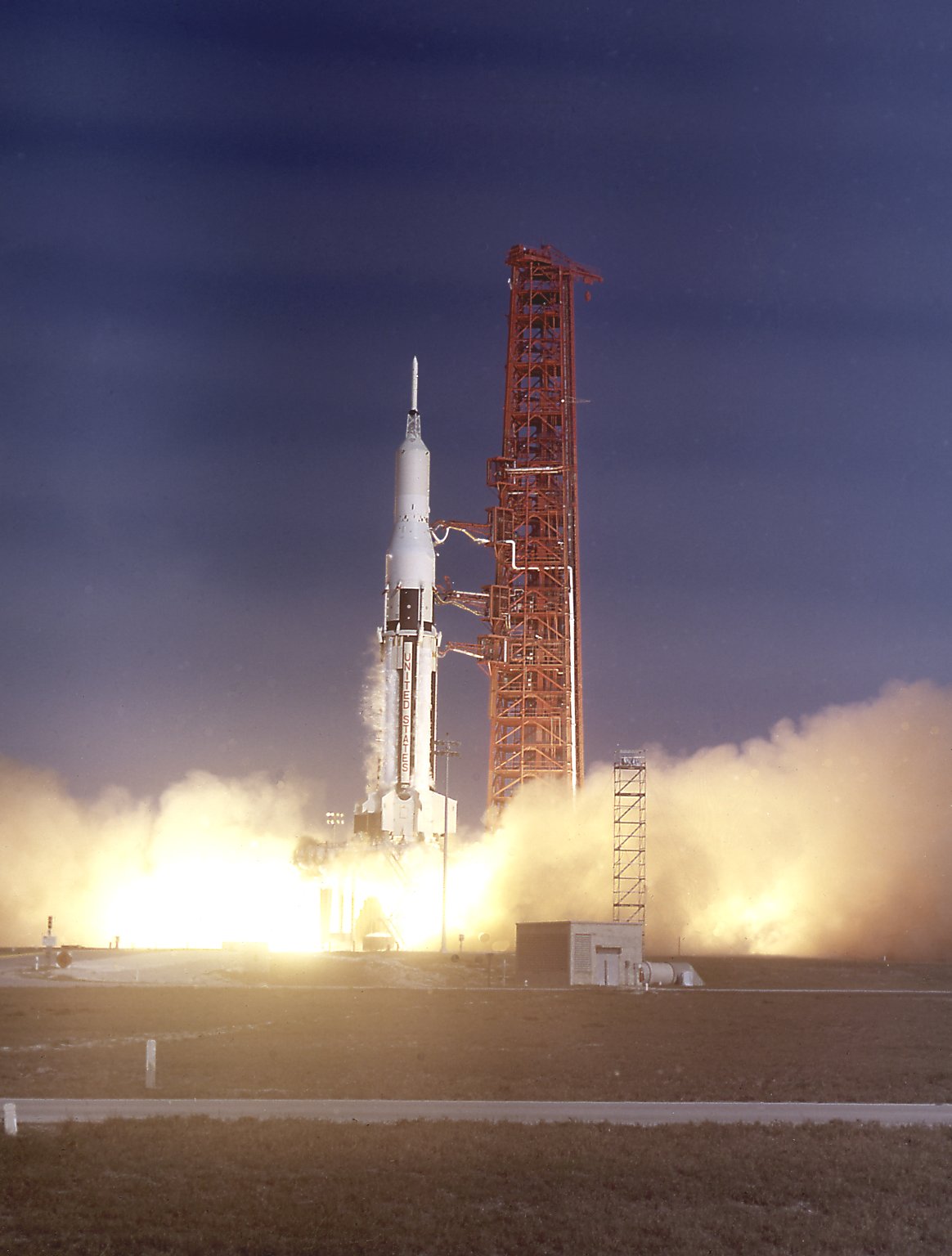
This week in 1965, SA-9, the first Saturn mission with an operational payload, launched carrying the Pegasus-1 satellite. Designed, produced and operated by NASA’s Marshall Space Flight Center, Pegasus-1, which studied punctures by potentially hazardous micrometeoroids at high altitudes, launched aboard the Marshall-built Saturn I rocket. The NASA History Program documents and preserves NASA’s remarkable history through a variety of products — photos, press kits, press releases, mission transcripts and administrators’ speeches. For more pictures like this one and to connect to NASA’s history, visit the History Program’s Web page. (NASA)
Obituaries
Roy Williams, 86, of Huntsville, died Feb. 13. He retired from the Marshall Center in 1984 as an aerospace engineer. He is survived by his wife, Peggy R. Williams.
Donald E. Pryor, 77, of Madison, Alabama, died Feb. 14. He retired from the Marshall Center in 1999 as an aerospace engineer. He is survived by his wife, Lyndall Pryor.




























